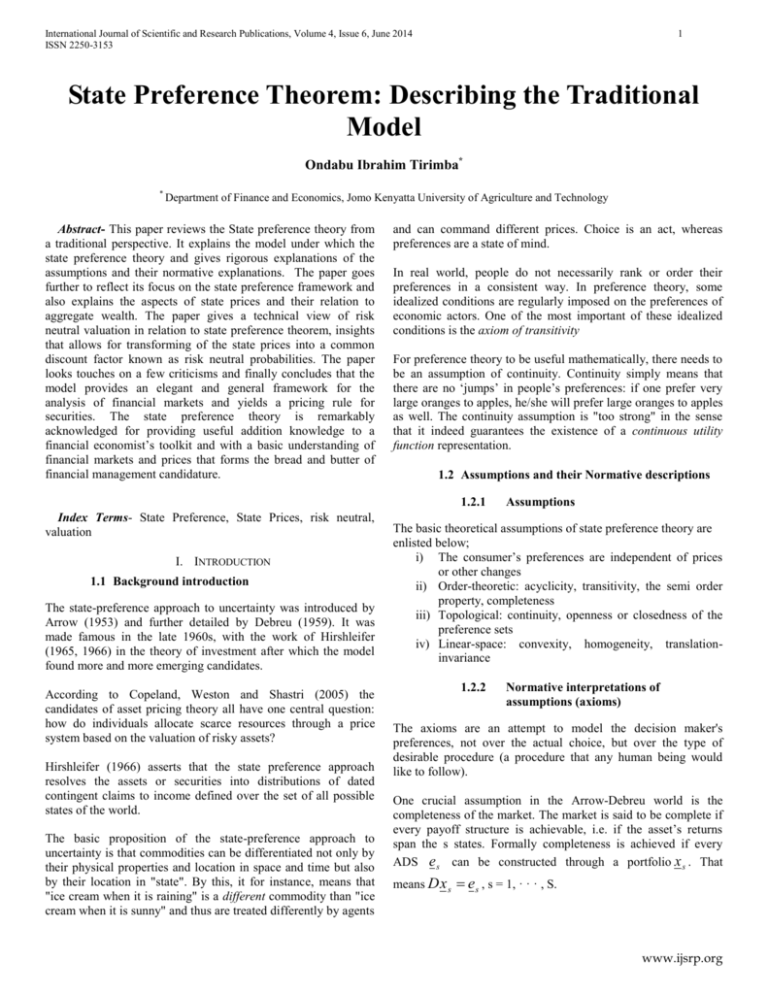
International Journal of Scientific and Research Publications, Volume 4, Issue 6, June 2014
ISSN 2250-3153
1
State Preference Theorem: Describing the Traditional
Model
Ondabu Ibrahim Tirimba*
*
Department of Finance and Economics, Jomo Kenyatta University of Agriculture and Technology
Abstract- This paper reviews the State preference theory from
a traditional perspective. It explains the model under which the
state preference theory and gives rigorous explanations of the
assumptions and their normative explanations. The paper goes
further to reflect its focus on the state preference framework and
also explains the aspects of state prices and their relation to
aggregate wealth. The paper gives a technical view of risk
neutral valuation in relation to state preference theorem, insights
that allows for transforming of the state prices into a common
discount factor known as risk neutral probabilities. The paper
looks touches on a few criticisms and finally concludes that the
model provides an elegant and general framework for the
analysis of financial markets and yields a pricing rule for
securities. The state preference theory is remarkably
acknowledged for providing useful addition knowledge to a
financial economist’s toolkit and with a basic understanding of
financial markets and prices that forms the bread and butter of
financial management candidature.
and can command different prices. Choice is an act, whereas
preferences are a state of mind.
In real world, people do not necessarily rank or order their
preferences in a consistent way. In preference theory, some
idealized conditions are regularly imposed on the preferences of
economic actors. One of the most important of these idealized
conditions is the axiom of transitivity
For preference theory to be useful mathematically, there needs to
be an assumption of continuity. Continuity simply means that
there are no ‘jumps’ in people’s preferences: if one prefer very
large oranges to apples, he/she will prefer large oranges to apples
as well. The continuity assumption is "too strong" in the sense
that it indeed guarantees the existence of a continuous utility
function representation.
1.2 Assumptions and their Normative descriptions
1.2.1
Index Terms- State Preference, State Prices, risk neutral,
valuation
I. INTRODUCTION
1.1 Background introduction
The state-preference approach to uncertainty was introduced by
Arrow (1953) and further detailed by Debreu (1959). It was
made famous in the late 1960s, with the work of Hirshleifer
(1965, 1966) in the theory of investment after which the model
found more and more emerging candidates.
According to Copeland, Weston and Shastri (2005) the
candidates of asset pricing theory all have one central question:
how do individuals allocate scarce resources through a price
system based on the valuation of risky assets?
Hirshleifer (1966) asserts that the state preference approach
resolves the assets or securities into distributions of dated
contingent claims to income defined over the set of all possible
states of the world.
The basic proposition of the state-preference approach to
uncertainty is that commodities can be differentiated not only by
their physical properties and location in space and time but also
by their location in "state". By this, it for instance, means that
"ice cream when it is raining" is a different commodity than "ice
cream when it is sunny" and thus are treated differently by agents
Assumptions
The basic theoretical assumptions of state preference theory are
enlisted below;
i) The consumer’s preferences are independent of prices
or other changes
ii) Order-theoretic: acyclicity, transitivity, the semi order
property, completeness
iii) Topological: continuity, openness or closedness of the
preference sets
iv) Linear-space: convexity, homogeneity, translationinvariance
1.2.2
Normative interpretations of
assumptions (axioms)
The axioms are an attempt to model the decision maker's
preferences, not over the actual choice, but over the type of
desirable procedure (a procedure that any human being would
like to follow).
One crucial assumption in the Arrow-Debreu world is the
completeness of the market. The market is said to be complete if
every payoff structure is achievable, i.e. if the asset’s returns
span the s states. Formally completeness is achieved if every
ADS e s can be constructed through a portfolio x s . That
means Dx s
es , s = 1, · · · , S.
www.ijsrp.org
International Journal of Scientific and Research Publications, Volume 4, Issue 6, June 2014
ISSN 2250-3153
Another key assumption which has to be made is the NoArbitrage profit condition. Interestingly, this condition was stated
as a "by-product" in the original works e.g. a necessary condition
in relation to the single-price law of markets, as in Hirshleifer
[1966], or excluded through assumptions about the prices of
ADS, as in Arrow [1953]. At that time nobody thought of
Arbitrage itself as a powerful tool for the valuation of assets and
a basis for sophisticated asset pricing theories on its own. In
modern textbooks which start with the introduction of an ArrowDebreu-like financial market the Arbitrage argument is followed
more elaborately and conclusions are made that go far beyond
the original works of SPT. Consumers whose preference
structures violate transitivity would get exposed to being milked
by some unscrupulous person.
The axiom of completeness implies that some choice will be
made, an assertion that is more philosophically questionable. In
most applications, the set of consumption alternatives is infinite
and the consumer is not conscious of all preferences. For
example, one does not have to choose over going on holiday by
plane or by train: if one does not have enough money to go on
holiday anyway then it is not necessary to attach a preference
order to those alternatives. However, preference can be
interpreted as a hypothetical choice that could be made rather
than a conscious state of mind. In this case, completeness
amounts to an assumption that the consumers can always make
up their mind whether they are indifferent or prefer one option
when presented with any pair of options.
In extremes, there is no "rational" choice available. For instance,
if asked to choose which one of one's children will be killed, as
in, there is no rational way out of it. In that case preferences
would be incomplete, since "not being able to choose" is not the
same as "being indifferent".
2.
The state preference model
2.1 State Preference Framework (SPT)
The SPT framework features two points in time: to as today and
t1 as tomorrow. Trading and portfolio optimization only occur
in to . The uncertainty in this framework is characterized through
2
a ...a represents the securities and has cardinality J. At time
1
j
t0 the prices of the existing securities are given by the vector
p1
p
p
j
p j is the price of a security a j . An important
Where: each
concept to be introduced are the
Arrow-Debreu-Securities, ADS henceforth,
es
aj
At time
a j ( w1 )
a (w
s
j
t0 it is not known which state will occur, but the
individuals know each possible payoff. The set
A =
0
1
0
This concept allows for the intuitive decomposition of every
payoff into a linear combination
of ADS. One can now further examine the array of possible
payoff structures. To do so one can condense the elements
introduced so far in a S × J payoff matrix D, that can be seen as
one of the simplest representations of a financial market.
Each row represents a state and each column represents a
security:
a1 ( w1 ) a2 ( w1 ) . . . aJ ( w1 )
a1 ( w2 ) a2 ( w2 ) . . . aJ ( w2 )
D
=
t1 from the finite set w1 ,...ws with
cardinality S. The investor might know the different probabilities
of the states, but he does not know which one is going to occur.
Securities can therefore be seen as a set of possible payoffs each
occurring in a mutually exclusive state of nature. Mathematically
speaking, they can be represented as a vector 1 of state
contingent claims or as a random variable. Represented as
vectors, securities assign a payoff to every possible state ws:
(e1 , e2 ,..., es ) .
Those securities yield a payoff of one monetary unit in a certain
state s and zero otherwise
.
.
.
.
various mutually exclusive and exhaustive future states that can
occur at time
.
.
.
.
.
.
a1 ( wS ) a2 ( ws ) . . . aJ ( ws )
x is defined as a linear combination of
securities of the following form, where each x j denotes the
Furthermore, a portfolio
number of each security held:
x1
x
x
j
2.2 State prices and their relation to aggregate
wealth
www.ijsrp.org
International Journal of Scientific and Research Publications, Volume 4, Issue 6, June 2014
ISSN 2250-3153
3
1
.
.
.
s
Dividing the state prices by their respective probabilities of the
state occurring one obtains the probability-adjusted willingness
to pay. As Dybvig and Ross (2003) argue that the marginal utility
of consumption is proportional to the relative scarcity. Defining
the state price density as
s
vs
S
s
Where ψs >> 0 and
S
p j S s asj E a j
s 1
Dividing the expression above by pj will yield a more convenient
representation for further calculations. By common economic
reasoning the quotient
a j p j denotes one plus the (uncertain)
expected return on security j written as
1998, p. 39]. Furthermore,
(1 R j ) [Zimmermann,
aj
1 E E (1 R j E X j
p j
Denoting the return on a riskless asset by X = (1 + R0) it can be
proven that the following relationship holds for the expected
return on security j:
E X j X X cov , X j
Expected return of a security depends on its covariance with the
state price density. The more negative the covariance the higher
the return. The interpretation is very valuable for our
understanding of asset prices: a negative covariance means that
asset payoffs are high when the state price density is low (hence,
the willingness to pay is low) and vice versa having assumed risk
aversion investors to be those are the states of the world where
aggregate wealth is high.
Bearing this risk is rewarded with more return. Securities with a
high proportion of non-diversifiable risk will have higher
expected rates of return. The securities that do not share that
economy risk will have lower rates of expected return since they
do not involve a lot of risk bearing in terms of aggregate wealth
levels.
3. Risk Neutral Valuation
One can construct a security that yields a payoff of one monetary
unit in each state, thus, making it risk free. Such a security would
be a pure discount bond trading at a risk free interest rate
discount. Thus, the sum of the state prices should equal the price
of the riskless investment:
S
V
k 1
k
1
............................................... (7)
1 R0
This insight allows transforming the state prices into a common
discount factor known as risk neutral probabilities. Following
Debreu [1959] define ψ as
s
V1
.
(1 R0 ) .
.
V
s
1
The ψ vector can be interpreted as a vector of probabilities since
they are all between zero and one and sum to one. Those
probabilities are called risk neutral probabilities – of course they
are not the "real probabilities", but using them simplifies
mathematical finance since one can use the rich mathematical
toolkit known from statistics. The value of a cash flow under risk
neutral valuation is its expected value under risk neutral
probabilities discounted at the risk free rate:
(1 R j ) will be denoted as
X j . Thus, one can write:
s 1
The asset pricing equation can be written as an expected value:
pj
1
1 R0
S
a
s 1
sj
s
1
E a j
1 Ro
Valuing with risk neutral probabilities is different from the
"traditional" approach. In the traditional approach the asset j is
valued by taking the expected value of the cash flows under
statistical probabilities denoted
E p a j and discounting it with
a risk adjusted rate of return denoted Rj. Thus, the risk
adjustment takes place in the denominator. Under risk neutral
probabilities the risk adjustment takes place in the numerator
when taking the expected value
E a j . To illustrate this
mathematically:
pj
4.
E p a j
1 Rj
or
E a j
1 R0
Criticisms of SPT
Some critics say that rational theories of choice and preference
theories rely too heavily on the assumption of invariance, which
states that the relation of preference should not depend on the
description of the options or on the method of elicitation.
Modigliani (1974) concedes that only an "infinite" liquidity
preference (an unlimited demand for money) will block return to
full-employment equilibrium in a free market.
But, as it be seen, heavy speculative demand for money speeds
the adjustment process. Moreover, the demand for money could
never be infinite because people must always continue
consuming, on some level, regardless of their expectations. Since
people must continue consuming, they must also continue
producing, so that there can be adjustment and full employment
regardless of the degree of hoarding.
It is assumed that the consumer’s preferences are independent of
prices or other changes. This assumption is not realistic. The
consumer’s preferences are bound to be affected by changes in
prices, or say, changes in fashion.
www.ijsrp.org
International Journal of Scientific and Research Publications, Volume 4, Issue 6, June 2014
ISSN 2250-3153
6. Conclusion
The State Preference Theory provides an elegant and general
framework for the analysis of financial markets and yields a
pricing rule for securities. This so-called state price vector can be
inferred from existing security prices in a complete capital
market and can value any new security introduced into the
market.
The SPT provides us with useful addition knowledge to a
financial economist’s toolkit and with a basic understanding of
financial markets and prices.
REFERENCES
[1]
[2]
[3]
[4]
[5]
[6]
H. Poor, An Introduction to Signal Detection and Estimation. New York:
Springer-Verlag, 1985, ch. 4.
Arrow, Kenneth J., 1953. “Hurwicz’s optimality criterion for decision
making under ignorance,” Technical Report 6, Stanford University
Thomas E. Copeland, J. FredWeston, and Kuldeep Shastri. Financial
Theory and Corporate Policy. Upper Saddle River, N.J: Pearson Addison
Wesley, fourth international edition, 2005.
Philip H. Dybvig and Stephen A. Ross. Arbitrage, state prices and portfolio
theory. In George M.
Constantinides, Milton Harris, and René M. Stulz, editors, Handbook of the
Economics of Finance, volume 1B. North Holland: Elsevier, 2003.
Gerard Debreu. Theory of Value. New Haven and London: Yale University
Press, 1959.
[7]
[8]
[9]
4
J. Hirshleifer. Investment decision under uncertainty: Choice-theoretic
approaches. The Quarterly Journal of Economics, 79(4):510–536, 1965.
J. Hirshleifer. Investment decision under uncertainty: Applications of the
state-preference approach. The Quarterly Journal of Economics, 80(2):252–
277, 1966.
Franco Modigliani and Gerald A. Pogue. An introduction to risk and return:
Concepts and evidence. Financial Analysts Journal, 30(2):68–80, 1974.
ACKNOWLEDGMENT
I acknowledge my fellow PHD Finance candidates who
clarified on pertinent ideas while writing this paper. Great
Thanks to Omurwa, Mutie, Wanyama, Muthama, Tayari and
Macharia. Much appreciated is my beloved parents; Daniel
Nyakundi and Prisca Ondabu, I don’t know how much to thank
you for making me believe in myself.
AUTHORS
First Author – Ondabu Ibrahim Tirimba, MBA-FINANCE,
CPA-K, PHD FINANCE candidate Jomo Kenyatta University of
Agriculture and Technology
Correspondence Author – Ondabu Ibrahim Tirimba,
tirimba5@gmail.com, ibraras@yahoo.com, +254711510110
www.ijsrp.org








